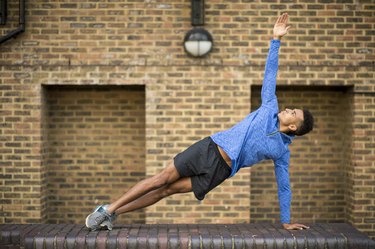
Side planks are a challenging move that targets your core — including your obliques and glutes — but you won't reap any of the ab-sculpting benefits unless you're using proper form. The best place to start in making them more effective? Keeping your hips lifted.
This simple adjustment maximizes your results (you'll really feel the burn in your obliques and gluteus medius) and helps prevent pain and injury.
Video of the Day
"Having firm obliques not only looks good, but it also prevents injuries, protects our spine and maintains our posture, and the side plank is the best exercise to target your obliques," says Lalitha McSorley, CPT, personal trainer and physiotherapist at Brentwood Physiotherapy.
The obliques — those muscles at the sides of your torso — laterally bend your trunk and rotate the trunk to the opposite side. So whether you're rolling over to shut off your morning alarm, bending down to tie your shoes or opening the fridge door, you are always subconsciously engaging your obliques.
Plus, "having strong obliques is associated with good balance and reduced risks of back injury, and the one thing most people don't realize is that a side plank works the deep spinal stabilizing muscle called quadratus lumborum, which is the stabilizing muscle that protects your spine," McSorley says.
But there's a bit of a Goldilocks situation with the side plank: You want to keep you hips lifted high but not too high. Here's how to find a position that's just right.
Proper Side Plank Form
- Lie on your left side with your legs extended out straight and your feet stacked one on top of the other.
- Place your left hand under your left shoulder.
- Lift your hips off the ground so that you're supporting your full weight on your left hand and left side of your left foot.
- Ensure your neck is neutral, take a deep breath out and tighten your core.
- Focus on your hips: Does it feel like the bottom one is sagging? Lift them a few inches higher. Do you feel like your body is making a rainbow shape? Lower them down to a more neutral alignment. You should feel your bottom obliques engage without crunching them in half.
- Continue to breath as you hold this position for 10 to 60 seconds.
- Repeat on the right side.
2 Tips to Keep Your Hips Lifted During Side Plank
"If you haven't built up the strength to lift your hips and hold your body in a straight line, you will notice your hips begin to sag," McSorley says. You can fix this common mistake by following a few tips:
1. Reduce Your Hold Time
To start, don't hold your side plank so long. Aim for a shorter time frame — even 10 seconds — really focusing on your obliques, then work your way up to 30 and eventually 60 seconds.
"Over time, your obliques will get stronger and the sagging will stop and keeping your hips elevated will keep your core activated," McSorley says.
2. Check Your Form in a Mirror
It might feel like you're as straight as an arrow, but there's a good chance you're a little off center, so get a friend or a mirror to make sure things are in line. If neither are available, try placing your hand on your hip while doing a side plank. "The additional weight and pressure will naturally cause your hips to go down," McSorley says.
Another good way to avoid raising the hips during a side plank is by placing a ruler or a light wooden bar parallel to your spine. If you have correct side plank form, the bar will be point to your toes and head. "It will be very obvious if the hips aren't are too high as the bar will not run parallel [to your body]," she says.